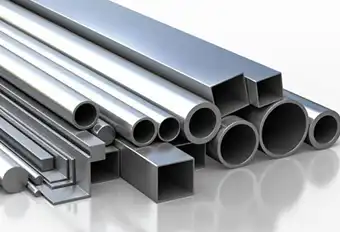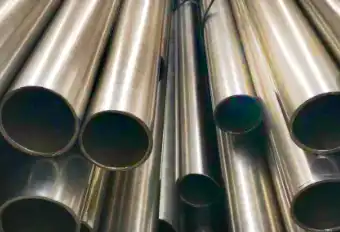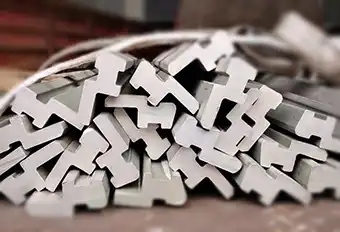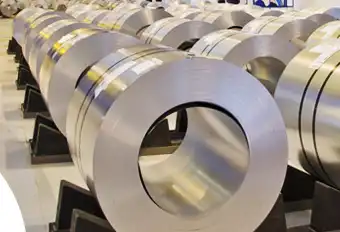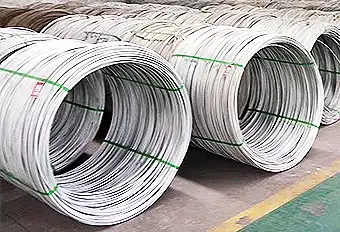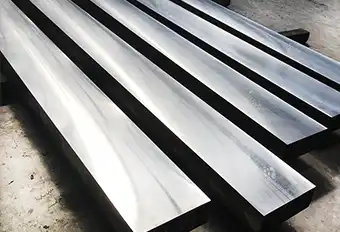The simplest version of analyzes the effects of alloying elements on iron-carbon alloys would require analysis of a large number of ternary alloy diagrams over a wide temperature range. However, Wever pointed out that iron binary equilibrium systems fall into four main categories (Fig. 1): open and closed γ-field systems, and expanded and contracted γ-field systems. This approach indicates that alloying elements can influence the equilibrium diagram in two ways:
- by expanding the γ-field, and encouraging the formation of austenite over wider compositional limits. These elements are called γ-stabilizers.
- by contracting the γ-field, and encouraging the formation of ferrite over wider compositional limits. These elements are called α-stabilizers.
The form of the diagram depends to some degree on the electronic structure of the alloying elements which is reflected in their relative positions in the periodic classification.
Figure 1. Classification of iron alloy phase diagrams: a. open γ-field; b. expanded γ-field; c. closed γ-field
(Wever, Archiv, Eisenhüttenwesen, 1928-9, 2, 193)
Class 1: open γ-field. To this group belong the important steel alloying elements nickel and manganese, as well as cobalt and the inert metals ruthenium, rhodium, palladium, osmium, iridium and platinum. Both nickel and manganese, if added in sufficiently high concentration, completely eliminate the bcc α-iron phase and replace it, down to room temperature, with the γ-phase. So nickel and manganese depress the phase transformation from γ to α to lower temperatures (Fig. 1a), i.e. both Ac1 and Ac3 are lowered. It is also easier to obtain metastable austenite by quenching from the γ-region to room temperature, consequently nickel and manganese are useful elements in the formulation of austenitic steels.
Class 2: expanded γ-field. Carbon and nitrogen are the most important elements in this group. The γ-phase field is expanded, but its range of existence is cut short by compound formation (Fig.1b). Copper, zinc and gold have a similar influence. The expansion of the γ-field by carbon, and nitrogen, underlies the whole of the heat treatment of steels, by allowing formation of a homogeneous solid solution (austenite) containing up to 2.0 wt % of carbon or 2.8 wt % of nitrogen.
Class 3: closed γ-field. Many elements restrict the formation of γ-iron, causing the γ-area of the diagram to contract to a small area referred to as the gamma loop (Fig. 1c). This means that the relevant elements are encouraging the formation of bcc iron (ferrite), and one result is that the δ- and γ-phase fields become continuous. Alloys in which this has taken place are, therefore, not amenable to the normal heat treatments involving cooling through the γ/α-phase transformation. Silicon, aluminium, beryllium and phosphorus fall into this category, together with the strong carbide forming elements, titanium, vanadium, molybdenum and chromium.
Class 4: contracted y-field. Boron is the most significant element of this group, together with the carbide forming elements tantalum, niobium and zirconium. The γ-loop is strongly contracted, but is accompanied by compound formation (Fig. 1d).
The distribution of alloying elements in steels. Although only binary systems have been considered so far, when carbon is included to make ternary systems the same general principles usually apply. For a fixed carbon content, as the alloying clement is added the y-field is either expanded or contracted depending on the particular solute.
With an element such as silicon the γ-field is restricted and there is a corresponding enlargement of the α-field. If vanadium is added, the γ-field is contracted and there will be vanadium carbide in equilibrium with ferrite over much of the ferrite field. Nickel does not form a carbide and expands the γ-field. Normally elements with opposing tendencies will cancel each other out at the appropriate combinations, but in some cases anomalies occur. For example, chromium added to nickel in a steel in concentrations around 18% helps to stabilize the γ-phase, as shown by 18Cr8Ni austenitic steels.
One convenient way of illustrating quantitatively the effect of an alloying element on the γ-phase field of the Fe-C system is to project on to the Fe-C plane of the ternary system the γ-phase field boundaries for increasing concentration of a particular alloying element. For more precise and extensive information, it is necessary to consider series of isothermal sections in true ternary systems Fe-C-X, but even in some of the more familiar systems the full information is not available, partly because the acquisition of accurate data can be a difficult and very time-consuming process.
Recently the introduction of computer-based methods has permitted the synthesis of extensive thermochemical and phase equilibria data, and its presentation in the form, for example, of isothermal sections over a wide range of temperatures.
If only steels in which the austenite transforms to ferrite and carbide on slow cooling are considered, the alloying elements can be divided into three categories:
- elements which enter only the ferrite phase
- elements which form stable carbides and also enter the ferrite phase
- elements which enter only the carbide phase.
In the first category there are elements such as nickel, copper, phosphorus and silicon which, in transformable steels, are normally found in solid solution in the ferrite phase, their solubility in cementite or in alloy carbides being quite low.
The majority of alloying elements used in steels fall into the second category, in so far as they are carbide formers and as such, at low concentrations, go into solid solution in cementite, but will also form solid solutions in ferrite. At higher concentrations most will form alloy carbides, which are thermodynamically more stable than cementite.
Typical examples are manganese, chromium, molybdenum, vanadium, titanium, tungsten and niobium. Manganese carbide is not found in steels, but instead manganese enters readily into solid solution in Fe3C. The carbide-forming elements are usually present greatly in excess of the amounts needed in the carbide phase, which are determined primarily by the carbon content of the steel. The remainder enters into solid solution in the ferrite with the non-carbide forming elements nickel and silicon. Some of these elements, notably titanium, tungsten, and molybdenum, produce substantial solid solution hardening of ferrite.
In the third category there are a few elements which enter predominantly the carbide phase. Nitrogen is the most important element and it forms carbo-nitrides with iron and many alloying elements. However, in the presence of certain very strong nitride forming elements, e.g. titanium and aluminum, separate alloy nitride phases can occur.
While ternary phase diagrams, Fe-C-X, can be particularly helpful in understanding the phases which can exist in simple steels, isothermal sections for a number of temperatures are needed before an adequate picture of the equilibrium phases can be built up. For more complex steels the task is formidable and equilibrium diagrams can only give a rough guide to the structures likely to be encountered. It is, however, possible to construct pseudobinary diagrams for groups of steels, which give an overall view of the equilibrium phases likely to be encountered at a particular temperature.
Structural changes resulting from alloying additions. The addition to iron-carbon alloys of elements such as nickel, silicon, manganese, which do not form carbides in competition with cementite, does not basically alter the microstructures formed after transformation. However, in the case of strong carbide-forming elements such as molybdenum, chromium and tungsten, cementite will be replaced by the appropriate alloy carbides, often at relatively low alloying element concentrations. Still stronger carbide forming elements such as niobium, titanium and vanadium are capable of forming alloy carbides, preferentially at alloying concentrations less than 0.1 wt%.
It would, therefore, be expected that the microstructures of steels containing these elements would be radically altered. It has been shown how the difference in solubility of carbon in austenite and ferrite leads to the familiar ferrite/cementite aggregates in plain carbon steels. This means that, because the solubility of cementite in austenite is much greater than in ferrite, it is possible to redistribute the cementite by holding the steel in the austenite region to take it into solution, and then allowing transformation to take place to ferrite and cementite. Examining the possible alloy carbides, and nitrides, in the same way, shows that all the familiar ones are much less soluble in austenite than is cementite.
Chromium and molybdenum carbides are not included, but they are substantially more soluble in austenite than the other carbides. Detailed consideration of such data, together with practical knowledge of alloy steel behavior, indicates that, for niobium and titanium, concentrations of greater than about 0.25 wt % will form excess alloy carbides which cannot be dissolved in austenite at the highest solution temperatures. With vanadium the limit is higher at 1-2%, and with molybdenum up to about 5%. Chromium has a much higher limit before complete solution of chromium carbide in austenite becomes difficult. This argument assumes that sufficient carbon is present in the steel to combine with the alloying element. If not, the excess metallic element will go into solid solution both in the austenite and the ferrite.
In general, the fibrous morphology represents a closer approach to an equilibrium structure so it is more predominant in steels which have transformed slowly. In contrast, the interphase precipitation and dislocation nucleated structures occur more readily in rapidly transforming steels, where there is a high driving force, for example, in microalloyed steels.
The clearest analogy with pearlite is found when the alloy carbide in lath morphology forms nodules in association with ferrite. These pearlitic nodules are often encountered at temperatures just below Ac1, in steels which transform relatively slowly.
For example, these structures are obtained in chromium steels with between 4% and 12% chromium and the crystallography is analogous to that of cementitic pearlite. It is, however, different in detail because of the different crystal structures of the possible carbides. The structures observed are relatively coarse, but finer than pearlite formed under equivalent conditions, because of the need for the partition of the alloying element, e.g. chromium between the carbide and the ferrite. To achieve this, the interlamellar spacing must be substantially finer than in the equivalent iron-carbon case.
Interphase precipitation. Interphase precipitation has been shown to nucleate periodically at the γ/α interface during the transformation. The precipitate particles form in bands which are closely parallel to the interface, and which follow the general direction of the interface even when it changes direction sharply. A further characteristic is the frequent development of only one of the possible Widmanstätten variants, for example VC plates in a particular region are all only of one variant of the habit, i.e. that in which the plates are most nearly parallel to the interface.
The extremely fine scale of this phenomenon in vanadium steels, which also occurs in Ti and Nb steels, is due to the rapid rate at which the γ/α transformation takes place. At the higher transformation temperatures, the slower rate of reaction leads to coarser structures. Similarly, if the reaction is slowed down by addition of further alloying elements, e.g. Ni and Mn, the precipitate dispersion coarsens.
The scale of the dispersion also varies from steel to steel, being coarsest in chromium, tungsten and molybdenum steels where the reaction is relatively slow, and much finer in steels in which vanadium, niobium and titanium are the dominant alloying elements and the transformation is rapid.
Transformation diagrams for alloy steels. The transformation of austenite below the eutectoid temperature can best be presented in an isothermal transformation diagram, in which the beginning and end of transformation is plotted as a function of temperature and time. Such curves are known as time-temperature-transformation, or TTT curves, and form one of the important sources of quantitative information for the heat treatment of steels.
In the simple case of a eutectoid plain carbon steel, the curve is roughly C-shaped with the pearlite reaction occurring down to the nose of the curve and a little beyond. At lower temperatures bainite and martensite are formed. The diagrams become more complex for hypo- and hyper-eutectoid alloys as the ferrite or cementite reactions have also to be represented by additional lines.


